#basilissa
Explore tagged Tumblr posts
Text


86 notes
·
View notes
Text
"Stratonike evidently retained the Akkadian royal title used for her even after Antiochos’ death, since the astronomical diary entry identifies her as šarratu, in logograms GAŠAN, which means “queen.” In earlier centuries under previous regimes this title could not be used of a royal woman unless she also ruled. As suggestive as this is, there is no direct corroborating evidence for Stratonike exercising rulership, unless we credit her influence with her children as a form of political dominance. The trope of the domineering dowager queen mother should be familiar enough from interpretations of other royal families throughout history. But the diary, normally fairly precise in noting royal family connections, does not call her “mother [or widow] of the king,” meaning that at least some people remembered Stratonike as a queenly figure on her own, without reference to male relatives. This is an interesting hint at how these royal women could carry out their duties so as to be regarded as individual rulers in their own right."
— Gillian Ramsey, "Apama and Stratonike: The first Seleukid basilissai," "The Routledge Companion to Women and Monarchy in the Ancient Mediterranean World" (edited by Elizabeth D. Carney and Sabine Müller)
#historicwomendaily#stratonike#ancient history#hellenistic period#history#mine#It's so fascinating to compare the power and importance that the Babylonian astronomical diary gives her#with the way she's framed as a passive romantic figure and love interest by later classical writers#The contrast is striking#speaking of which:#I remember reading Elizabeth D. Carney's book 'Women and Monarchy in Macedonia'#where she spoke about Stratonike identifying with her birth family rather than her husbands as Basilissa#and speculates that it was because she had more influence with her brother than her husband and son#and also that there is no evidence of her playing any role in her husband or son's reigns#which is bizarre to me because it's...obviously not true. It's a conclusion drawn from silence without considering our terribly#scarce sources for the Seleukids during that time#But the evidence that we do have - especially this unusual reference in the astronomical diary - clearly indicates the OPPOSITE#Stratonike's specific identity as Basilissa certainly does not indicate her lack of influence - instead it indicates her autonomy and agenc#And while we lack hard evidence of her activities what this Babylonian reference indicates#She conducted a indivudual ruler in her own right#We lack evidence.#The lack of hard evidence of Stratonike's activities as queen & dowager certainly does not indicate that she had 'no role' during that time#instead this Babylonian reference indicates that not only was her political role considerable but that it was more akin to an individual#ruler in her own right#which is absolutely fascinating#It's just unfortunate that we lack specific evidence for her activities :(
5 notes
·
View notes
Text

Hl. Julian und hl. Basilissa von Ägypten
gefeiert am 9. Januar
Hl. Julian und hl. Basilissa Wohltäter, Märtyrer † um 304 oder 311 in Ägypten Wohltäter (beide), Märtyrer (Julian) † um 304 oder 311 in Ägypten
Julian und Basilissa, ein ägyptisches Ehepaar aus Antinoe, waren gegen ihren Willen verheiratet worden. Sie beschlossen, enthaltsam zu leben und sich dem Dienst an den Leidenden zu widmen. Daher öffneten sie ihr Haus für Kranke und Notleidende und machten es zu einem Ort der Krankenpflege und Fürsorge. Basilissa starb Anfang des 4. Jahrhunderts, bald danach wurde Julian in der diokletianischen Verfolgung wegen seiner Verweigerung des Kaiseropfers gefangengenommen. In der Gefangenschaft bekehrte er den Sohn und die Mutter des römischen Statthalters sowie weitere Personen, mit denen er schließlich hingerichtet wurde.
Die Verehrung des Paares setzte früh ein, sie sind u.a. bereits im Martyrologium Hieronymianum, einem Märtyrerverzeichnis der Antike, enthalten.
Reliquien befinden sich in den Kirchen Santa Maria Maggiore und Sankt Paul vor den Mauern in Rom sowie im Markusdom in Venedig.
#Heiliger Julian#Heilige Basilissa#Wohltäter#Märtyrer#saint#Ägypten#Ehepaar#Enthaltsam#Leiden#Krankenpflege#Fürsorge#Bekehrt#saints#saint of the day#heiliger des tages#god#gott#christ#jesus#religion#lord here i am#christianity#faith#glaube#holy#heilig#catholic#roman catholic#catholic posting#catholicism
0 notes
Text
Atlantis: The Women.
Cesaria Mirilla Rivers.

Basilissa Lorelei Rivers.

Basilissa Auralure Rivers.

Basilissa Aquaria Rivers.

Basilissa Calliroe Rivers.

Made with https://www.azaleasdolls.com/dressupgames/greek-gods.php.
#wip: atlantis#cesaria wateria rivers#basilissa auralure rivers#basilissa calliroe rivers#basilissa aquaria rivers#basilissa lorelei rivers#ancient greek costuming#ancient greek hairstyling#azalea's dolls
1 note
·
View note
Text
Allsaint’s Cafe Daily Special for January 9: Eggs Julian and Basilissa

Eggs Benedict topped with dukkah. Comes with two sides, and must be ordered for 2 people. Price halved upon providing proof you two met yesterday for Allsaint’s Cafe Allsingle’s Night™️.
1 note
·
View note
Text
"Kleopatra II, as the first basilissa spousal co-ruler, jointly held power with Ptolemy VI, and then Ptolemy VIII, during which time she saw to the political, religious, and international affairs of Egypt. She was also the first basilissa-regnant, ruling the administrative center of Egypt on her own for a period of at least three to four years. Her ability to rule Alexandria on her own and her feminization of the dating protocol would allow several successive queens to follow in her footsteps, most notably, Kleopatra VII."
— Tara L. Sewell-Lasater, Becoming Kleopatra: Ptolemaic Royal Marriage, Incest, and the Path to Female Rule (Dissertation, University of Houston) / Anne Bielman Sánchez and Giuseppina Lenzo, "Ptolemaic Royal Women", The Routledge Companion to Women and Monarchy in the Ancient Mediterranean World
"Kleopatra I left behind her three minor children: Ptolemy VI, his sister Kleopatra II, and his brother Ptolemy VIII. To strengthen this fragile royal power base, two operations were carried out: first, a marriage between Ptolemy VI and his younger sister was conducted in the spring of 175, then joint rule was established between the three siblings in 170. Even if Kleopatra II appears in the protocols of this ruling trio only in final position, behind the two kings, she nevertheless played a political role by mediating between her brothers in the Sixth Syrian War (Liv. 44.19.6; 45.11.3 and 6).
After the reconciliation of the siblings in 168, the ruling trio was active again, but tensions persisted and led to a split in 163: Ptolemy VIII became king of Kyrenaika while Ptolemy VI and his sister-wife began a joint rule over Egypt and Cyprus, a rule that lasted until the death of Ptolemy VI in 145. The queen then appears in all Greek and demotic protocols, in second position behind Ptolemy VI, and is often referred to as the “sister” or “sister and wife” (of the king). In addition, she officially participates in the management of the kingdom: the two sovereigns are invoked in the oaths of Egyptians and they receive petitions and reports in both their names and co-sign some royal orders and letters to officials. The honors for the queen and her husband in several gymnasiums in Kypros and Egypt confirm that she was considered the king’s partner by Greco-Macedonian inhabitants of Egypt.
The death of Ptolemy VI in the summer of 145 put an end to this duo and promoted Ptolemy VIII’s ambitions. Indeed, the option of a joint rule between Kleopatra II and her minor son is abandoned in favor of a joint rule between Kleopatra II and Ptolemy VIII. Through these events, the queen appears to be the legitimizing element of Ptolemaic power. In the protocols of the new joint rule, Kleopatra II regains her rank behind the king as well as her title of “sister” or “sister and wife” (of the king), while her role as an effective co-ruler of the kingdom seems to have been maintained. While the marriage in 141/140 of Ptolemy VIII and his niece—the daughter of Kleopatra II and Ptolemy VI—led to a ruling trio, Kleopatra II kept her place in the new configuration:��she appears in the second rank, behind the king, and is generally called “the sister” to distinguish herself from Kleopatra III, who is called “the wife.”.
The agreement between the trio shattered in 132, when the Alexandrians drove out Ptolemy VIII and Kleopatra III, and supported Kleopatra II. Kleopatra II’s two sons (one born of Ptolemy VI, the other of Ptolemy VIII) were murdered by order of Ptolemy VIII to prevent the queen from forming a joint rule with one of them. Kleopatra II was then forced to assume sole royal power: in 131 and 130, documents from cities in the south of the country (notably Thebes) mention a new sequence of regnal years, and a protocol of a Greek papyrus from Hermonthis is dated “under the reign of Kleopatra, goddess Philometor Soteira” (P. Baden Gr. II.2, October 29, 130).
After the failure of an alliance attempt with her son-in-law, the Seleukid king Demetrios II, Kleopatra II facing the military reconquest of the country by Ptolemy VIII, left Egypt in 127 and took refuge at the Seleukid court. However, her royal career was not over: in 124, thanks to negotiations between Ptolemies and Seleukids, she returned to a ruling trio with Ptolemy VIII and Kleopatra III, and regained the same rank and title as before the civil war. Finally, we cannot rule out the possibility that, after the death of Ptolemy VIII in 116, Kleopatra II briefly participated in a ruling trio with Kleopatra III and her son Ptolemy IX. She probably died in 115.
As a partner in six joint rules, Kleopatra II sets the record for the longest reign of a queen on the Ptolemaic throne (55 years)."
#HOW is she not more well-known?#Kleopatra II#Cleopatra II#Egyptian history#ancient egypt#ptolemaic egypt#women in history#historicwomendaily#my post#hellenistic period#ancient history#Ptolemy VI#Ptolemy VIII
19 notes
·
View notes
Text

it's ridiculous how hard mason bees are to identify, particularly in the western US where they're super diverse with at least 100 species most of which look extremely similar. i have this little sapphire narrowed down to most likely either Osmia cyanella or O. cobaltina, depending on how i interpret a tiny carina on the underside of the head that's mostly hidden by legs and mouthparts, though i also haven't confidently ruled out O. grindeliae, bella, or basilissa, the last two of which might be real species or just synonyms of cobaltina, depending on if i use the janky and unfinished discoverlife Osmia key or the 85 year old monograph by Sandhouse.
#hymenoptera#megachilidae#osmia#dead bugs#if youre wondering why its been mostly reruns on here lately its because ive been too busy going crazy with bee ID to take photos
74 notes
·
View notes
Text

Не о такой я мечтал - не тебе чета.
Basileus and basilissa - the most disarranged marriage in the entire Empire.
12 notes
·
View notes
Text
120 years ago: The Grand Duchesses celebrate Easter in 1905
Like many people in 2025, the Romanov Grand Duchesses celebrated the Holy days leading up to the Resurrection by attending Church, gathering with their family, and painting Easter eggs. Христос воскрес!
The eldest Grand Duchess Olga Nikolaevna, then nine years old in 1905, wrote about the day in her diary:
12 Degrees 16/29. Saturday. Martyrdom of Leonida and Khionii Holy Saturday Non-attendance day. We were all at church, had breakfast with Papa and Mama. Irina, Andrei, Feodor and we all coloured eggs together. We drank tea.
Irina Alexandrovna, Andrei Alexandrovich, and Feodor Alexandrovich were the Grand Duchesses' cousins, the children of their Aunt Kseniya and Uncle Sandro.
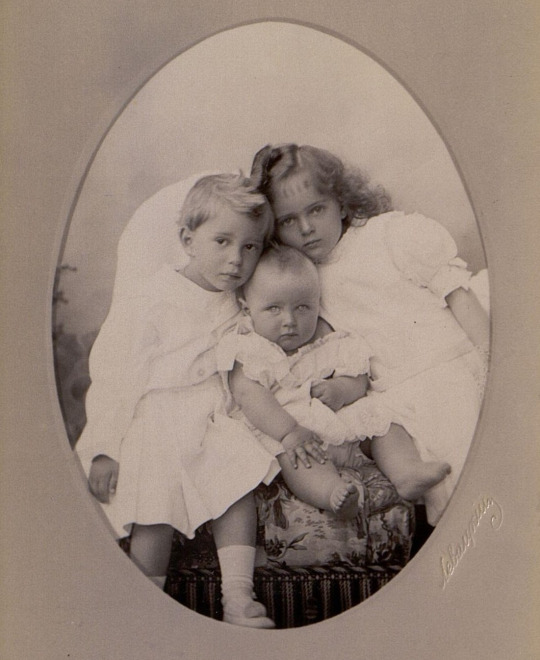

Left photo: Andrei on the left, Feodor in the middle, Irina on the right
Right photo: Irina on the left, Andrei in the middle, Feodor on the left
Numerous Orthodox Martyrs are celebrated on 16 April [Old Style]. I believe that the Martyrdom of Leonida refers to the Holy Martyr Leonidas and The Seven Virgins; Saints Chariessa, Nice, Galina, Kalista, Nunechia, Basilissa, Theodora, and Irine, Martyrs of Corinth. They were imprisoned and killed for their faith. I believe that the Martyrdom of Khionii is in reference to the Holy Marters Agapia, Chionia, and Irina, who were killed for their faith.

Sources
📍 Scanned photograph of Olga Nikolaevna's diary, page 110, GARF. F.640. Op.3. D.17. L.50. f.899, shared by Ilya (Следствие) -- Bold italics in my translation denote diary typesetting. The girls' diaries had important days incorporated into their diaries. 'Non-attendance day' denotes a religious holiday is observed, and public and legal affairs must not be carried out.
📍 Translation: my own - please give appropriate credit to GARF, Ilya, and my tumblr :)
📷 Photograph of Irina, Andrei, and Feodor shared by lesyoussoupoff, 8 October 2023
📷 Photograph of Irina, Andrei, and Feodor sat in a model boat, from the book 'Family Album: From the History of a Photo Studio'
#Happy Easter!#I'm a little late sorry!#OTMA#Saw some ‘history’ tiktoks that were AI generated :( so here’s some actual history :’)#Olga Nikolaevna#Tatiana Nikolaevna#Maria Nikolaevna#Anastasia Nikolaevna#sources#diaries#Irina Alexandrovna#Andrei Alexandrovich#Feodor Alexandrovich#Romanov sisters#cousins
14 notes
·
View notes
Text
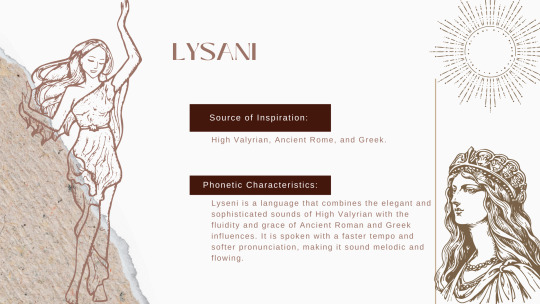
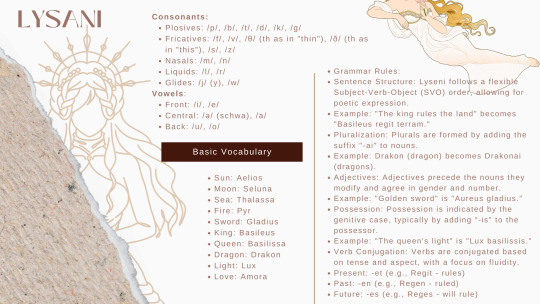
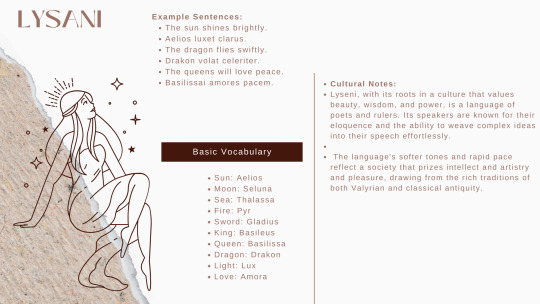
𝕿𝖍𝖊 𝕷𝖞𝖘𝖊𝖓𝖎 𝕷𝖆𝖓𝖌𝖚𝖆𝖌𝖊: 𝖙𝖍𝖊 𝖑𝖆𝖓𝖌𝖚𝖆𝖌𝖊 𝖔𝖋 𝖑𝖔𝖛𝖊.
Lyseni is a language that combines the elegant and sophisticated sounds of High Valyrian with the fluidity and grace of Ancient Roman and Greek influences. It is spoken with a faster tempo and softer pronunciation, making it sound melodic and flowing.
Basic Vocabulary:
Sun: Aelios
Moon: Seluna
Sea: Thalassa
Fire: Pyr
Sword: Gladius
King: Basileus
Queen: Basilissa
Dragon: Drakon
Light: Lux
Love: Amora
Consonants:
Plosives: /p/, /b/, /t/, /d/, /k/, /g/
Fricatives: /f/, /v/, /θ/ (th as in "thin"), /ð/ (th as in "this"), /s/, /z/
Nasals: /m/, /n/
Liquids: /l/, /r/
Glides: /j/ (y), /w/
Vowels:
Front: /i/, /e/
Central: /ə/ (schwa), /a/
Back: /u/, /o/
Lyseni, with its roots in a culture that values beauty, wisdom, and power, is a language of poets and rulers. Its speakers are known for their eloquence and the ability to weave complex ideas into their speech effortlessly. The language's softer tones and rapid pace reflect a society that prizes intellect and artistry and pleasure, drawing from the rich traditions of both Valyrian and classical antiquity.
𝐃𝐎 𝐍𝐎𝐓 𝐑𝐄𝐁𝐋𝐎𝐆 𝐓𝐇𝐈𝐒 𝐔𝐍𝐋𝐄𝐒𝐒 𝐖𝐄 𝐀𝐑𝐄 𝐌𝐔𝐓𝐔𝐀𝐋𝐒. 𝐓𝐇𝐈𝐒 𝐈𝐒 𝐀 𝐇𝐄𝐀𝐃𝐂𝐀𝐍𝐎𝐍 𝐅𝐎𝐑 𝐌𝐄 𝐀𝐍𝐃 𝐓𝐎 𝐁𝐄 𝐒𝐇𝐀𝐑𝐄𝐃 𝐖𝐈𝐓𝐇 𝐌𝐘 𝐑𝐎𝐋𝐄𝐏𝐋𝐀𝐘 𝐌𝐔𝐓𝐔𝐀𝐋𝐒.
12 notes
·
View notes
Note
What was Alexander’s relationship with his sisters like?
Short answer: We mostly don’t know.
Alexander and His Sisters
Longer answer: We have some clues that he may have got on well at least with Kleopatra and Thessalonike. Kynanne is more of a crap-shoot, as she was married to his cousin and rival, Amyntas. But as Philip arranged that marriage, she had little/no say in the matter, so we just don’t know what she thought of her husband-cousin versus her brother. (Not addressing the infant Europe, as she died at just a few weeks.)
First, let me link to an article by Beth Carney, and at the end, I’ll add some links to my own prior entries that address the question too.
Elizabeth Carney, “The Sisters of Alexander the Great: Royal Relics” Historia 37.4 (1988), 385-404.*
Beth’s article discusses Argead marriage policies, and the fate of the women after ATG’s death. I know she’s changed her mind about a few things, but it’s still well worth reading.
Also, a general reminder to folks who may be new to Alexander/Macedonia … Macedonian kings practiced royal polygamy: e.g., they married for politics, not love, and had more than one wife at the same time. Philip married 7 women (the most of any Macedonian king), although there weren’t 7 wives living in the palace at once. There may have been as many as 5 at times, however.
Because of royal polygamy, they did not use the term basilissa (queen) until after Alexander’s death. The chief wife was the mother of the heir; she had the most power. Because of the rivalry inherent in such courts, a woman’s primary allegiance was to her son, not her husband. Her secondary allegiance would be to her father (if living) and/or brothers. This was not unique to Macedonia, but a feature of most courts with polygamous structures.
These are not love matches, although our later sources may present them as love matches. (These authors had their own ideological reasons for such characterizations.) Did love never come after marriage? Perhaps. It would have depended. Also, within the women’s rooms, wives may have allied with each other at points, particularly if several of them. If only two (as seems more characteristic in Macedonia, aside from Philip), they’d have been rivals seeking to produce the heir.
I state all that to explain why Alexander’s sisters may have courted their brother’s affection (and protection), after Philip’s death. Only Kleopatra had a son, and he was 12 at most at Alexander’s death.

In his final year, Philip married off Alexander’s older sister, Kynanne (d. of Audata, ergo half- Illyrian), and Alexander’s younger and only full sister, Kleopatra (d. of Olympias). Kleopatra’s wedding was literally the day before Philip’s assassination. The timing of Kynnane’s marriage is less clear, but Philip married her to Amyntas, his nephew (her cousin), some time after his own marriage to his last wife, Kleopatra Eurydike. Kynnane had a daughter by Amyntas, Hadea (later Hadea Eurydike). We’re not sure if she was born before or after her father’s execution by Alexander, but it does let us nail down her age to c. 12/13 at Alexander’s death.
After he had Amyntas executed, Alexander planned to marry Kynnane to one of his trusted allies, Langaros, king of Agriana, which lay north of Macedonia, between Paionia and Illyria. Agriana was arguably Paionian, but similar to Illyria. Ergo, this may show a bit of thoughtfulness on Alexander’s part, to match his sister to a man who wouldn’t attempt to trammel her. Recall that Illyrian women wielded more power and even fought in battle. Yet Langaros died (perhaps of injury) before Alexander could make good on that.
It would be the last time Alexander planned any nuptials for his sisters. In part because he invaded Persia not long after, but it wouldn’t have stopped him from summoning one of them if he’d really wanted to marry her off.
Kynanne raised her daughter Hadea in traditional Illyrian ways, which Alexander allowed (although he probably couldn’t have stopped her). After his death, she took off to Asia to see Hadea married to her uncle, (Philip III) Arrhidaios. Kynanne was murdered by Perdikkas’s brother Alkestas, because Perdikkas (then regent) didn’t want the marriage. BUT the army (who liked and respected Kynanne) forced Alkestas to allow it anyway. Hadea (now) Eurydike and Philip III Arrhidaios eventually fell under Kassandros’s authority/possession, where she/they opposed Olympias and baby Alexander IV (and Roxane).
It was inevitable that the co-kingship that followed ATG’s death wouldn’t hold, and Hadea, who clearly wore the pants, wasn’t about to step aside for her cousin Alexander IV. Nor did Kassandros want them to, as he could control them. He couldn’t control Olympias. Yet none of that would necessarily reflect how Kynanne and Hadea had felt about their brother/uncle during his lifetime.
So, we must say the jury is out on Kynanne’s relationship with Alexander.
But for Kleopatra and Thessalonike, I do believe we have enough hints that they cared for him and he for them.
Kleopatra’s husband (another Alexander, of Epiros) died in combat in Italy in 332—around the time Alexander was besieging Tyre and Gaza, or four years after their marriage. In that time, Kleopatra produced two children, a girl (Kadmea) and a boy (Neoptolemos). The girl was named to honor her uncle’s victory over Thebes,** which happened at the tail-end of 335. As Alexander of Macedon and Alexander of Epiros both left on separate campaigns in 334, the boy would have to have been fathered not long after Kadmea was born. (It’s possible that Alexander of Epiros didn’t get to Italy until 333.)
After Alexander of Epiros’s death, Kleopatra did not marry again, although after her brother died, she had a couple marriage offers/offered marriage herself. She was THE prize during the early Successor wars…the full sister of Alexander.
Two titbits might suggest she was close to him (even if he didn’t marry her off again). First, the name of her first child is for his victory, not one by her husband. Sure, Alexander of Epiros didn’t have a battle victory at that point to name her for…but he could have insisted on a family name. Instead, he let Kleopatra give the child a name celebrating Alexander of Macedon’s victory. I suspect she fought for that.
Second, an anecdote reports that when Alexander was told his sister was having an affair some years after she’d become a widow, he reportedly replied, “Well, she ought to have a little fun.” This, btw, was viewed as a bad answer…e.g., he didn’t properly discipline her. As Alexander was constantly used for moral lessons (good or bad), we should take it with a grain of salt. But it’s possible his approximate reaction was preserved and became fodder for moralizing about those wild, half-barbarian Macedonians from the north…couldn’t keep their women in check!
As for Thessalonike, data here is also circumstantial. She stayed with Olympias after Alexander’s death and was never married until after Olympias herself was killed by Kassandros—who then forced her to marry him to cement his claim to the Macedonian throne. She had a sad life, at least in her latter years. Her eldest son (Philip) wasn’t healthy and died not long after he became king. Her second son (Antipatros) and her last son (Alexandros) apparently hated each other. After Philip’s death, Thessalonike argued that Antipatros should co-rule with the younger Alexandros. So Antipatros killed his mother! (Matricide, folks, is SUPER-bad.) Then Alexandros killed Antipatros, and was eventually killed in turn by Demetrios Poliorketes.
Well, if Justin can be trusted, and there are problems with Justin. Ergo, it’s possible that internecine spate of murders didn’t go the way Justin reports.
Yet the naming of her youngest boy may tell a story, along with her insistence that he co-rule with his brother.
There’s also the legend of Mermaid Thessalonike, but we can’t take that as any sort of evidence.
Here are some additional posts that also talk about the sisters:
“Writing Kleopatra and Alexander’s Other Sisters” — Although aimed primarily at the novels, it obviously must deal with the girls as historical persons. Pretty short for me.
“What Philip Thought about His Other Children” — A sideways take on this same question. Not long.
“On Amyntas” — About Alexander’s older cousin, his real rival for the throne when Philp was assassinated. Also discusses Kynanne as a matter-of-course. Not long.
“On Kassandros” — Mostly about Antipatros’s son Kassandros, who had Alexander IV murdered, but also discusses Thessalonike, who he forced to marry him. Relatively long.
--------------------------------------------
* The link takes you to academia.edu, where, by clicking on Beth’s name, you can find more of her articles. Keep in mind the woman has something north of 150, many on women, PLUS a bunch of books. Not everything is uploaded due to copyright, but several of her older articles are, such as this one.
** It was something of a “thing,” at least in Macedon, for daughters to be named in honor of their father’s victories. Kynanne not so much, but Kleopatra means “Glory of Her Father,” and both Thessalonike (Victory in Thessaly) and Europe (Victory in Europe) reflected their father’s triumphs.
#asks#alexander the great#alexander the great's sisters#kleopatra of macedon#thessalonike of macedon#kynnane of macedon#hadea eurydike#philip II of macedon#philip of macedon#alexander of epirus#classics#ancient macedonia#ancient greece#alexander's sisters#ancient greek family relations
22 notes
·
View notes
Text
SAINTS&READING" FRIDAY, APRIL 4, 2025
march 22_april 4
HIEROMARTY BASIL, PRESBYTER OF ANCINA (362)

Hieromartyr Basil was a presbyter in Ancyra, Galatia. Fighting against the Arian heresy, he urged his flock to cling firmly to Orthodoxy. Because of this Saint Basil was deposed from his priestly rank by a local Arian council, but a Council of 230 bishops in Palestine reinstated him.
Saint Basil openly continued to preach and denounce the Arians. Therefore, he became the victim of persecution and was subjected to punishment as a man dangerous to the state. Two apostates, Elpidios and Pegasios, were ordered to turn Saint Basil from Orthodoxy. The saint remained unshakable, and was again subjected to tortures.
When the emperor Julian the Apostate (361-363) arrived in the city of Ancyra, Saint Basil bravely confessed Christ before him at the trial, and denounced the emperor for his apostasy. Julian ordered that strips of skin be cut from the saint’s back. Saint Basil endured the gruesome torture with great patience.
When they began to beat his shoulders and stomach with red-hot rods, he fell down upon the ground from the torments and cried out, “O Christ, my Light! O Jesus, my Hope! Quiet Haven from the stormy sea. I thank You, O Lord God of my fathers, that You have snatched my soul from the pit of Hell and preserved Your Name in me unstained! Let me finish my life a victor and inherit eternal life according to the promise You gave my fathers. Now accept my soul in peace, remaining steadfast in this confession! For You are merciful and great is Your mercy, You Who live and sojourn throughout all the ages. Amen.”
Having made such prayer, and lacerated all over by the red-hot rods, the saint fell into a sweet slumber, giving up his soul into the hands of God. The Hieromartyr Basil died June 29, 362. His commemoration was transferred to March 22 because of the Feast of Saints Peter and Paul.
This saint should not be confused with Saint Basil of Ancyra (January 1), a layman.
MARTYRS CALLINICA AND BASSILICA OF ROME (2nd c.)
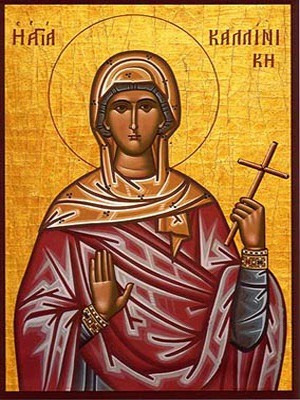
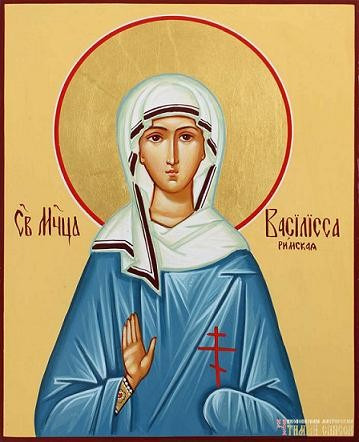
Saints Basilissa (Βασίλισσα) and Kalliniki (Καλλίνικη) were from Galatia. Since Saint Basilissa was wealthy, she gave money to Saint Kalliniki to go to the prison and distribute it to the Christians who were confined there for their sustenance, and so they would pray for her. She wished to prepare them for martyrdom and to stand by them so that they would not lose their courage amid their tribulations.
One day Saint Kalliniki was arrested and they asked her why she was giving the prisoners money. Since she did not know how to lie, she admitted the truth. That is why they tied her up and handed her over to the ruler. Afterward, Saint Basilissa was arrested and was brought before him in court. Both women boldly confessed Christ and were subjected to various tortures, in an attempt to make them deny their faith and offer sacrifice to the idols.
Since they could not be persuaded to do so, their sacred heads were cut off with swords. In this manner they defeated the devil and rejoiced in the Kingdom of Heaven. The martyrdom of the Holy Martyrs Basilissa and and Kalliniki took place in the year 252, during the reign of Emperor Gallus (251-253).


Isaiah 45:11-17
11 Thus says the Lord, The Holy One of Israel, and his Maker: “Ask Me of things to come concerning My sons; And concerning the work of My hands, you command Me. 12 I have made the earth, And created man on it. I—My hands—stretched out the heavens, And all their host I have commanded. 13 I have raised him up in righteousness, And I will direct all his ways; He shall build My city And let My exiles go free, Not for price nor reward,” Says the Lord of hosts. 14 Thus says the Lord: “The labor of Egypt and merchandise of Cush And of the Sabeans, men of stature, Shall come over to you, and they shall be yours; They shall walk behind you, They shall come over in chains; And they shall bow down to you. They will make supplication to you, saying, ‘God is with you only, and there is no other; no god besides him.' 15 Truly You are God, who hide Yourself, O God of Israel, the Savior! 16 They shall be ashamed And also disgraced, all of them; They shall go in confusion together, Who are makers of idols. 17 But Israel shall be saved by the Lord With an everlasting salvation; You shall not be ashamed or disgraced Forever and ever.
Proverbs 17:17-18:5
17 A friend loves at all times, And a brother is born for adversity.
18 A man devoid of understanding shakes hands in a pledge, And becomes surety for his friend.
19 He who loves transgression loves strife, And he who exalts his gate seeks destruction.
20 He who has a deceitful heart finds no good, And he who has a perverse tongue falls into evil.
21 He who begets a scoffer does so to his sorrow, And the father of a fool has no joy.
22 A merry heart does good, like medicine, But a broken spirit dries the bones.
23 A wicked man accepts a bribe behind the back To pervert the ways of justice.
24 Wisdom is in the sight of him who has understanding, But the eyes of a fool are on the ends of the earth.
25 A foolish son is a grief to his father, And bitterness to her who bore him.
26 Also, to punish the righteous is not good, Nor to strike princes for their uprightness.
27 He who has knowledge spares his words, And a man of understanding is of a calm spirit.
28 Even a fool is counted wise when he holds his peace; When he shuts his lips, he is considered perceptive.
1 A man who isolates himself seeks his own desire; He rages against all wise judgment.
2 A fool has no delight in understanding, But in expressing his own heart.
3 When the wicked comes, contempt comes also; And with dishonor comes reproach.
4 The words of a man's mouth are deep waters; The wellspring of wisdom is a flowing brook.
5 It is not good to show partiality to the wicked, Or to overthrow the righteous in judgment.
#orthodoxy#orthodoxchristianity#easternorthodoxchurch#originofchristianity#spirituality#holyscriptures#gospel#bible#wisdom#faith#saints
3 notes
·
View notes
Text
"There is one clear early Hellenistic example of a regnant basilissa: Amastris, who ruled Herakleia Pontika after the death of her husband, its tyrant Dionysios. She eponymously founded the neighboring city of Amastris c. 300 BCE, and from there issued coins bearing the legend “of basilissa Amastris" (ΑΜΑΣΤΡΙΟΣ ΒΑΣΙΛΙΣΣΗΣ). Like many other women ruling as monarchs, Amastris came into direct power because her husband had died and her sons were under age. She brought her own royal credentials to the situation, however, as a niece of Dareios III (daughter of his brother Oxyathres). Like Apama, Alexander had married her to one of his generals (Krateros). After 323 Krateros swapped her for Phila, and she moved to Herakleia to live with Dionysios, who, as Memnon tells us later (probably after 306), began to call himself basileus. Although supervising the regency for her sons, Amastris faced interventions by Antigonos Monophthalmos, ostensibly on the children’s behalf, to control Herakleia, and then by Lysimachos, who also married her. By 300 she was solo again with no outside interference, and her foundation of Amastris marks the point when she fully embraced the role of a regnant basilissa. Although her sons soon came of age, she maintained this role until they assassinated her c. 284."
— Gillian Ramsey, "Apama and Stratonike," The Routledge Companion to Women and Monarchy in the Ancient Mediterranean World (Edited by Elizabeth D. Carney and Sabine Müller)
17 notes
·
View notes
Text
Lore of my cyberbyzantine guys? Lore of my cyberbyzantine guys!
(the main ones, I don't have enough time even for doodle portraits of all the cast lol)

(from left to right: Mikhail, Irina, Constantine, Alexios)
Mikhail VI Porphyrogenitus
The ruling basileus and autokrator of Ustrelian Empire, and the man responsible (for the most part) for everything that went horribly wrong. Both Mikhail's father and grandfather were emperors (which is an incredibly long royal lineage for ustrelian rulers, who normally don't even die a natural death), also he's the first reigning emperor in centuries to be born into the family of a reigning emperor. Unfortunately for Mikhail, his emperor dad was forced to leave his position (lethally) when he was still a kid, and the boy was rised as a puppet emperor by his grandfather's closest companion, the despot and grand domestic (=commander-in-chief of the imperial army) Phocas Sebastos. When Phocas died of old age, Mikhail began to reign by himself, but his perception of things got a bit... blurred due to his upbringing, so he made several critical mistakes. Like starting a world war in response to minor geopolitical failures. Oops.
Irina
Basilissa of Ustrelian empire and Mikhail's wife, she was the only daughter of Phocas Sebastos, destined by her father to marry Mikhail from the day she was born. However, over time (and after her father's death) she starts to oppose Mikhail and his policies, having her own ideas about what her homeland should be like. Thus she's one of the most dangerous players in the local game of thrones, the leader of reformist/liberal political faction and the femme fatale of the story. Ironically, she also ends up as an ally and close friend of Alexios, who was her failed first choice for the classic "me and my warlord lover overthrow my emperor husband and rule the empire together (meaning I rule and my lover wages his wars somewhere far enough away to not bother me, sometimes bringing me glorious victories)" scheme.
Constantine Tyflos
A member of an old noble ustrelian family, strategos (=military governor) of the Heliolea theme and Mikhail's second best military commander. Also Mikhail's childhood friend, or, more correctly, "friend", because Mikhail bullied him all his life. He was also the one who helped Alexios start his military career (hoping to use his skills to his advantage), but it ended as it ended. As a result, Constantine is super pissed off at Mikhail, Alexios and literally everyone else, and agrees to participate in one of Irina's schemes. It ends terribly for him: the scheme is revealed, his lover and accomplice Irina betrays him to save her position, and he gets his eyes gouged out as a punishment for the state treason (Constantine was also locked in the dungeon for a while, but Alexios lets him out when he becomes a caesar).
Alexios III Kataktitis
Grand domestic and caesar (=lesser co-ruling emperor), a sickly lowborn man with a quiet, humble temper and stunningly brilliant talent for the art of warfare. He lied to join the army after Mikhail's world war was nearly lost for the ustreli (mostly for suicidal reasons, he didn't know about his genius back then) and quickly rose throught the ranks to become the greatest military commander of the empire (and the world at large) within a decade. He's also the second person responsible for everything that went horribly wrong (or, in his case, horribly right) - it turned out that a mortal man was not supposed to conquer the entire world according to, like, divine level of laws, and now the God Himself is very displeased by the ustreli in general and Alexios in particular. Oops [2].
Bonus: glossary or "how all the names sound to their author i.e. without romanization because western and slavic translations of greek names are just sooo different lol"
Ustrelian Empire, ustreli - Юстрéльская империя, юстрéли;
Phocas Sebastos - Фока Севаст;
Heliolea - Гелиолея;
the quartet of characters - василевс Михаил Багрянородный, василиса Ирина, стратиг Константин Слепец, кесарь Алексий Завоеватель.
#local ocs rumbling#it's always rainy in Nineva (original story tag)#yeah I've made a special tag for this we're so in it now
4 notes
·
View notes
Text


Spotted Kleopatra Selene's coin at the museum! The coin bears the inscription 'Basilissa Kleopatra' and was discovered in the ruins of Volubilis (25 BC- 5 BC)
9 notes
·
View notes
Text

Queen Drichglur is thrilled that King Goffredo is showing her love and appreciation by taking the effort to learn her native language - Sardinian Vulgar. Given how Lustful King Goffredo is, they both spend some time together alone, in their bedchambers.
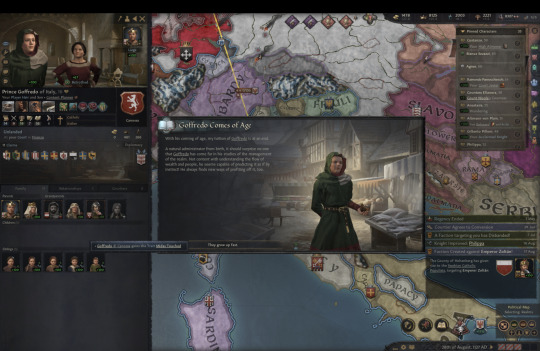
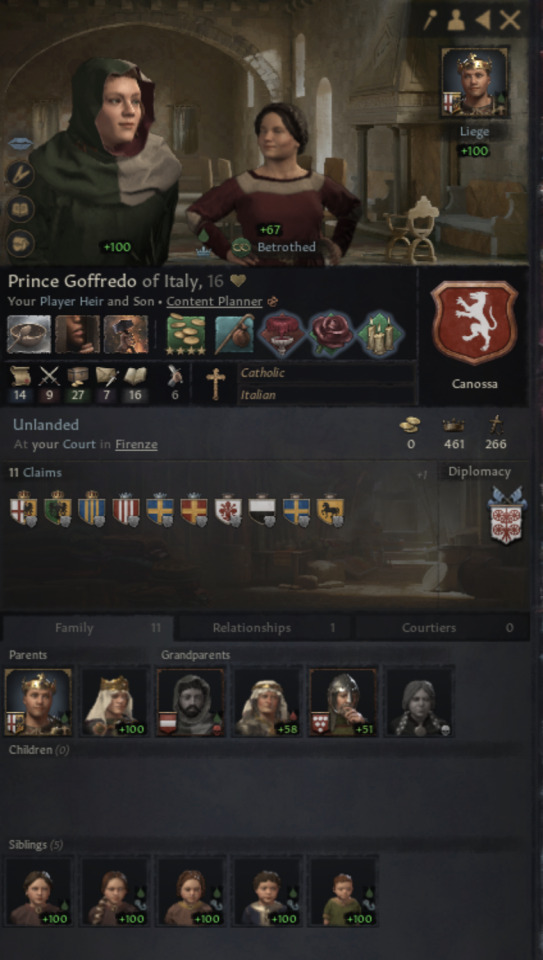
Soon, Prince Goffredo comes of age and becomes a Midas Touched (Level 4 Stewardship education). Besides that, he is also a secret Homosexual.
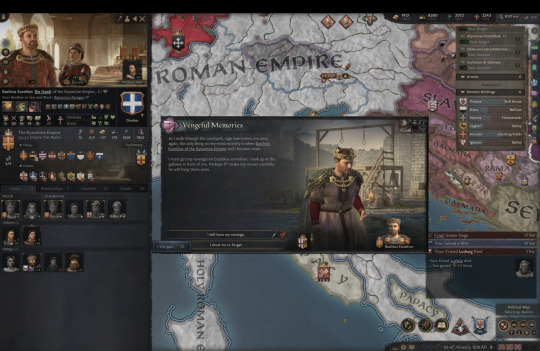
King Goffredo is beset with Vengeful Memories of how Basileus Eusebios of the Byzantine Empire abused his eldest sister Basilissa Anna. He contemplates making the man hang for his crimes as he gazes upon the gallows.
However, King Goffredo checks himself. God teaches us to forgive our neighbours and enemies for their trespasses against us, just as God forgives us of our trespasses. The fleeting thought of revenge passes from his mind.


King Goffredo's beneficiary Kopke, crafts an Illustrious Furniture which he names "Kopke's Statue". King Goffredo renames it as "Statue of King Goffredo", because that is what the statue depicts.
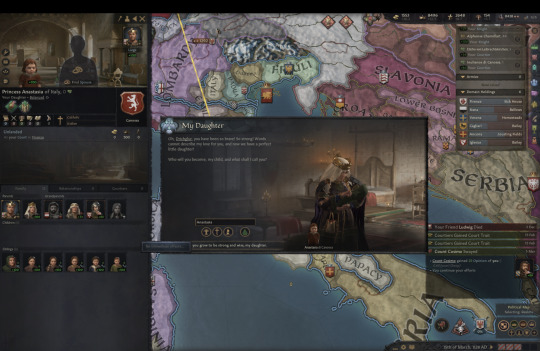
Queen Drichglur gives birth to their 4th daughter, Princess Anastasia of Italy, who is Comely and Intelligent.
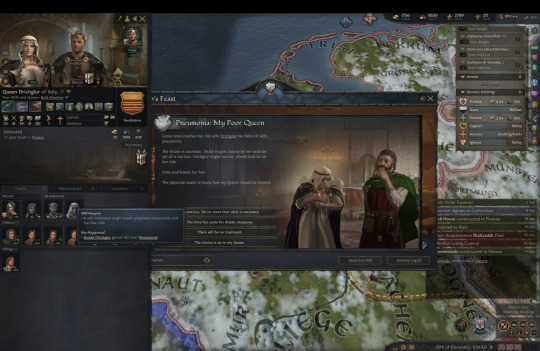

Within the span of 6 months, Queen Drichglur contracts Pneumonia, is given a safe treatment which is successful and recovers from Pneumonia in June of 1129.
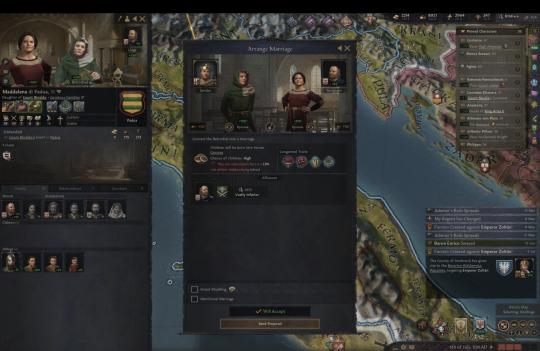
Soon, Maddalena di Padua, the daughter of Count Rinaldo, who is Amazonian, marries Prince Goffredo. With their union, their child has the chance of inheriting Beautiful, Intelligent, Herculean/Amazonian and Bleeder traits. This is on top of a 1.9% risk of their children being Inbred.

Finally, for his last Hold Court event, King Goffredo commissions the building of the City of Asciano in the County of Siena at the behest of his Steward, Count Eugenio of Polesine.
The construction would take 5 years to complete however, and we won't be playing King Goffredo in this file anymore. Thus concludes the adventures of King Goffredo and his grandmother Queen Matilda (formerly Duchess Matilda).
In the next post update, we will be playing Roads to Power DLC, with a brand new starting character! Let's look forward to it!
2 notes
·
View notes